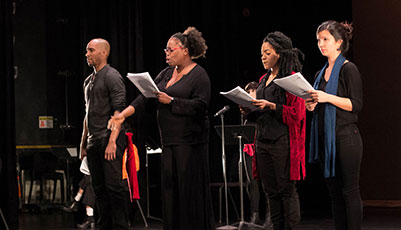
Sexual violence remains among the most sensitive, hot-button societal issues, yet all too often, the word “rape” is still uttered only in whispered tones, much as words such as “cancer” and “polio” were spoken in decades past. One team-taught course in John Jay’s Interdisciplinary Studies Program is hoping to change the nature of the discussion and bring the topic out of the shadows, spearheaded by an evening of student-led theater called “Seeing Rape.”
Click here for Opening Night photos.
On March 17-19, the Gerald W. Lynch Theater presented a program of 10 student-written plays that, in the words of Professors Shonna Trinch and Barbara Cassidy, “represent sexual violence and envision sexual justice in new and nuanced ways.”
Trinch and Cassidy co-teach the fall semester ISP course “Sex, Gender and Justice: Seeing Rape,” which in 2016 had 72 students enrolled. The course examines rape “as both an idea and an act,” and explores how rape and sexual violence are represented in law, media, film, theater, literature, performance art, and pop music.
For their final project, the students used what they have learned to write original plays based on the class material. The professors then selected the work of several students — 16 in the latest group — for refinement, resubmission and presentation in a live stage performance by professional actors.
The performance, now in its fourth year, was previously mounted in John Jay’s Black Box Theater, a venue with a limited seating capacity. For the newest iteration, Trinch noted, President Jeremy Travis donated the use of the Lynch Theater, which holds upward of 650 and offers opportunities for more professional stagecraft. The gamble paid off handsomely, with full houses for each of the three performances.
One aspect of the presentation that has not changed over time, Trinch emphasized, was the use of professional actors to perform the students’ work. “We want to feature the student writers,” she said, “and that’s why they’re at the top of the bill — and why we use working actors, not students, for the performance. The whole program is so powerful, it’s why actors keep coming back year after year.”
 Cassidy directed the production, and used her connections in the theatrical world to recruit the actors.
Cassidy directed the production, and used her connections in the theatrical world to recruit the actors.
The performances were more than just a night of theater, however. By inviting representatives from the NYPD, the Manhattan District Attorney’s Office, the Mayor’s Office to Combat Domestic Violence, and the community at large, Trinch said, she and Cassidy sought to “create a town-and-gown initiative that sends a powerful message about sexual violence to the community.” Performances were followed by panel discussions and question-and-answer sessions with the playwrights and actors, and Susan Herman, the NYPD’s Deputy Commissioner for Collaborative Policing, moderated the Sunday matinee.
Ultimately, Trinch noted, “We want to create the model sexual justice program for the nation. It’s not just art. One way of humanizing justice is through the arts. We’re hoping for broader representations of rape, so we can eliminate it, and end shaming. It’s important for me and for the College to reduce the harm done by rape, and ultimately aid student success.”
On the bill for this year’s “Seeing Rape” production were:
“The Movement,” by Danielle Baker (Computer Science major); “A Modern Romance,” by Irene Kontonicolas (Law and Society); “The Girl,” by Mirnelly Fernandez (Forensic Psychology); “Cycles End,” by LaShea Haynes (Criminal Justice; “The Blind Reflection,” by Carlos Rosado (Security Management), Nelson Carrillo (Economics), and Kevin Peña (Criminology); “An Ordinary Day,” by Abraham Tejeda Jr. (Law and Society); “La familia de papá,” by Bianca Suazo (International Criminal Justice), Yire Suárez (Criminal Justice), Vilmary Colon (Criminal Justice), and Eric Norales (Law and Society); “Unintended,” by Marell Ellis (Sociology); “Colorful Markers,” by Angelica Moreno (Political Science) and Adrian Simon (Fraud Examination and Financial Forensics); “Jubilee,” by Jasmine García (Culture and Deviance).



